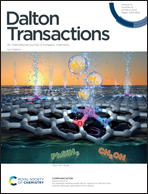Two Co(ii)/Ni(ii) complexes based on nitrogenous heterocyclic ligands as high-performance electrocatalysts for the hydrogen evolution reaction†
Abstract
Two transition metal complexes {[Co2(bpda)4(H2O)2]·4H2O}n(Co-1) and {[Ni(bpda)2(H2O)2]·2H2O}(Ni-2) (H2bpda = 2,2′-bipyridine-4,4′-dicarboxylic acid) have been synthesized by a hydrothermal method and characterized. These two compounds can be explored as stable electrocatalysts in the hydrogen evolution reaction (HER) using two important parameters: the overpotential and Tafel slope (TS). Electrochemical studies suggest that the reaction kinetics of a Co-1 catalyst is more favorable than that of a Ni-2 catalyst. Co-1 exhibits better HER performance with an overpotential of 182 mV at a current density of 10 mA cm−2, a small TS of 87.21 mV dec−1 and superior long-term durability (of up to 3000 cycles). Structural analysis shows that its catalytic activity is improved due to the two mixed valence cobalt ions and the pore structure formed by hydrogen bonds in Co-1, which is different from that of Ni-2. In addition, the mechanism of the HER is also explained theoretically by DFT molecular orbital and free energy calculations in this article.



 Please wait while we load your content...
Please wait while we load your content...